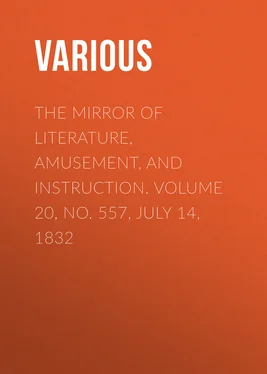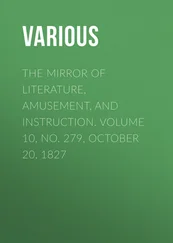Various - The Mirror of Literature, Amusement, and Instruction. Volume 20, No. 557, July 14, 1832
Здесь есть возможность читать онлайн «Various - The Mirror of Literature, Amusement, and Instruction. Volume 20, No. 557, July 14, 1832» — ознакомительный отрывок электронной книги совершенно бесплатно, а после прочтения отрывка купить полную версию. В некоторых случаях можно слушать аудио, скачать через торрент в формате fb2 и присутствует краткое содержание. Жанр: foreign_antique, periodic, Развлечения, foreign_edu, на английском языке. Описание произведения, (предисловие) а так же отзывы посетителей доступны на портале библиотеки ЛибКат.
- Название:The Mirror of Literature, Amusement, and Instruction. Volume 20, No. 557, July 14, 1832
- Автор:
- Жанр:
- Год:неизвестен
- ISBN:нет данных
- Рейтинг книги:3 / 5. Голосов: 1
-
Избранное:Добавить в избранное
- Отзывы:
-
Ваша оценка:
- 60
- 1
- 2
- 3
- 4
- 5
The Mirror of Literature, Amusement, and Instruction. Volume 20, No. 557, July 14, 1832: краткое содержание, описание и аннотация
Предлагаем к чтению аннотацию, описание, краткое содержание или предисловие (зависит от того, что написал сам автор книги «The Mirror of Literature, Amusement, and Instruction. Volume 20, No. 557, July 14, 1832»). Если вы не нашли необходимую информацию о книге — напишите в комментариях, мы постараемся отыскать её.
The Mirror of Literature, Amusement, and Instruction. Volume 20, No. 557, July 14, 1832 — читать онлайн ознакомительный отрывок
Ниже представлен текст книги, разбитый по страницам. Система сохранения места последней прочитанной страницы, позволяет с удобством читать онлайн бесплатно книгу «The Mirror of Literature, Amusement, and Instruction. Volume 20, No. 557, July 14, 1832», без необходимости каждый раз заново искать на чём Вы остановились. Поставьте закладку, и сможете в любой момент перейти на страницу, на которой закончили чтение.
Интервал:
Закладка:
"They swommin full of smale fishes lighte,
With finnis rede, and scalis silver brighte."
A single impression of his John Dorée sold lately in London for ten guineas. And when they do come out, though every admirer will lament he was, long ere completion, called to his blessed account, their sorrow will be softened at beholding with what effect and spirit his animated graver has been caught up by his son."
In the summer of 1828, Bewick visited London about his works. "He was," says Mr. Dovaston, "very honourably received by many learned societies and individuals, of whom, and of whose collections, he wrote in raptures. On his return, the London and provincial papers had many paragraphs respecting this visit, his reception, and his life; to amend the errors of which statements, I must have been writing one at the very hour of his death; for I had not time to stop its insertion in one of the Shrewsbury papers, when I received a short, but most affectionate and affecting letter from his son, informing me, 'as his father's most valued friend,' that he expired, in full possession of his fine and powerful mental faculties, in quiet and cheerful resignation, on the 8th of November, 1828, in the 76th year of his age. On the morning of his death he had the satisfaction of seeing the first proof-impression of a series of large wood-engravings he had undertaken, in a superior style, for the walls of farm-houses, inns, and cottages, with a view to abate cruelty, mitigate pain, and imbue the mind and heart with tenderness and humanity; and this he called his last legacy to suffering and insulted Nature."
MANNERS AND CUSTOMS
FUNERAL GARLANDS
Mr. Rhodes, in his interesting Excursions in Derbyshire , notices the following rite at the village of Hathersage: "In this church we observed the traces of a custom that once generally prevailed in various parts of the kingdom, but is now almost totally disused; when unmarried women died, they were usually attended to the grave by the companions of their early years, who, in performing the last sad offices of friendship, accompanied the bier of the deceased with garlands tastefully composed of wreaths of flowers and every emblem of youth, purity, and loveliness, that imagination could suggest. When the body was interred, the garlands were borne into the church, and hung up in a conspicuous station, in memory of the departed. In Hathersage Church there were several of these memorials of early dissolution, but only one of a recent date: the others were covered with dust, and the hand of time had destroyed their freshness."
In Mr. Tymms's Family Topographer , vol. ii. we read—"In Stockton Church, Wilts, is a piece of iron frame-work, with some remains of faded ribbon depending from it. It is the last remain of the custom of carrying a garland decorated with ribbons before the corpse of a young unmarried woman, and afterwards suspending it in the church. This instance occurred about thirty years ago."
THE DRUIDS AND THEIR TIMES
The people were, during this period, in a state of the most abject vassalage; two classes alone possessing all rank and dignity, and for the most part all the riches of the country. These were the Druids and the warriors. The former composed an order consisting of three classes, Druids, Prophets, and Bards; all of whom were subject to the power of the Arch-Druid. To this order appertained the knowledge of all the sciences which were then understood. The Druids were the expounders of religious mysteries, the framers of laws, the pronouncers of judgments, and the arbitrators of rewards or punishments. The immunity which they enjoyed from war, allured many young men to enrol themselves in this order. Their education was a poetical one, for it was necessary to learn by rote several thousand verses, in which all the knowledge then extant was contained.
Kings were the servants of the Druids; and could not, without their sanction, declare war or conclude peace; nor even assemble a council. In reality, the Druids possessed the kingly power, and those who bore the name of royalty, were the mere agents who executed their commands. The first had all the authority; the latter only the odium, which attached itself to the office of the sovereign. In matters of little importance, they yielded to the monarch a trifling pre-eminence. He was permitted to wear seven different colours in his cloak, while they were modestly content with six. But even in things of imaginary importance, the Druids took care, that while they conceded but little to their king, no one should be nearly equal to them in dignity. Persons of the highest rank were only allowed to wear four colours, and the inferior grades proportionally fewer. The Druids wore long garments reaching to their heels; all others had them so short that they scarcely covered the knees. Their hair was kept short, the rest of the nation wore theirs long; while they suffered their beard to grow, others were obliged to submit their chins to the knife. They carried in their hand a white staff, called " Slatan drui eachd
Конец ознакомительного фрагмента.
Текст предоставлен ООО «ЛитРес».
Прочитайте эту книгу целиком, купив полную легальную версию на ЛитРес.
Безопасно оплатить книгу можно банковской картой Visa, MasterCard, Maestro, со счета мобильного телефона, с платежного терминала, в салоне МТС или Связной, через PayPal, WebMoney, Яндекс.Деньги, QIWI Кошелек, бонусными картами или другим удобным Вам способом.
1
The Mirror , it will be remembered, was the first work of its class that presented this economical attraction to the public: the Engravings throughout the Series number upwards of Eight Hundred.
2
In the Museum at Newcastle, are many of the identical specimens from which Bewick drew his figures for the wood-cuts of his zoological works.
3
See a paper on "the Life, Genius, and Personal Habits of Bewick," in the Magazine of Natural History , vol. iii.; by his friend, John F. Dovaston, Esq., A.M., of Westonfelton, near Shrewsbury. There is a vein of generous enthusiasm—a glow of friendship—a halo of the finest feelings of our nature—throughout and around this memoir, which has the sincerity and singleness of heart of—A FRIEND.
4
In Mr. Dovaston's paper is a misprint, which it may be as well to notice here. It is stated that Bewick cut the Old Exchange, at Newcastle, (the vignette of the above volume) in 1719.
Интервал:
Закладка:
Похожие книги на «The Mirror of Literature, Amusement, and Instruction. Volume 20, No. 557, July 14, 1832»
Представляем Вашему вниманию похожие книги на «The Mirror of Literature, Amusement, and Instruction. Volume 20, No. 557, July 14, 1832» списком для выбора. Мы отобрали схожую по названию и смыслу литературу в надежде предоставить читателям больше вариантов отыскать новые, интересные, ещё непрочитанные произведения.
Обсуждение, отзывы о книге «The Mirror of Literature, Amusement, and Instruction. Volume 20, No. 557, July 14, 1832» и просто собственные мнения читателей. Оставьте ваши комментарии, напишите, что Вы думаете о произведении, его смысле или главных героях. Укажите что конкретно понравилось, а что нет, и почему Вы так считаете.












